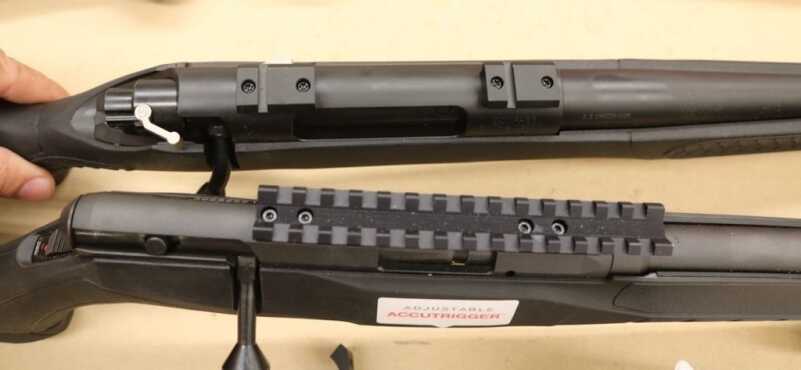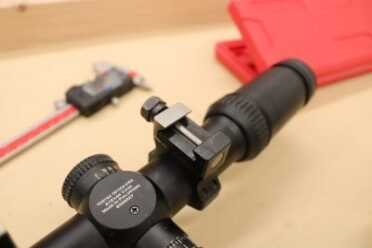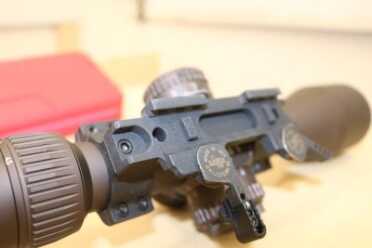I am a hater of Weaver style bases, and I will make no apologies. If I could wave my magic wand and make one firearms accessory disappear, it would be anything with a Weaver slot. Why so hateful? Glad you asked.
The Weaver rail was developed in the ’70s and is still very popular in the civilian market. It features a slotted base and studs that mount through them to secure scopes or other accessories. At the time of its development, it was a great idea. But a lot has changed since the ’70s.
The biggest problem with Weaver bases is that the slots are not evenly spaced. They are the same width, wherever you find them, but the space between the slots is not a set standard. This leads to all types of shenanigans when you try to swap scopes between rifles.
Picatinny was developed by the military in the ’90s. It also uses slots and studs but with one key difference: the slots are slightly wider and are always evenly spaced. Every MIL-SPEC Picatinny base in the world is the same.
SEE ALSO: Optics Buying Guide: Scope Mounts
Why does that matter to me? Like most of us, I have a lot more rifles than scopes. Good scopes are very expensive, often twice the price of a rifle. With a Picatinny system, provided the height is correct, I can easily transfer my one expensive scope to many different rifles.
If I have a Larue Picatinny mount, and I was smart enough to write down where it was set, I don’t even have to re-zero. Not only do I save money on optics, I can test rifles with an optic that would normally be silly.
If I think my battle rifle might be shot out, I am not at the mercy of the red dot on top of it for grouping. I can swap to my 4.5-27×56 Vortex Razor II and find out. If I want to do some inexpensive training, I can put the same Razor from my 6.5 Creedmoor on my .17 HMR and get some range time in on the cheap. I am training with the same reticle and controls, which is also a plus. And no way I am dedicating a $2,000 scope to a $300 gun. If I pay that much for glass, it is going to get some use.
Weaver doesn’t offer the same flexibility. Because the slots are unevenly spaced, I often have to take one ring completely off in order to get the scope to attach to the base. In the four rifles I shot this month with Weaver bases, I had to move the ring four times. I hate Weaver with a fiery passion because it wastes time.
[one_half]
[/one_half]
[one_half_last]
[/one_half_last]
The first thing I do with all my personal rifles is convert them to Picatinny. This is a cost saving measure as much as anything else. A good set of scope rings will often set you back $200. If you buy it once, in Picatinny, you are set for life. The cost of converting your Weaver base to Picatinny is often less than $50. For the price of one set of Weaver rings, I can convert four rifles to Picatinny. To me, this is a no brainer.
Much like the dinosaurs and muskets, it is time for Weaver to go the way of the dodo. It gave us some good times, but that time has passed.






I found the difference between the two systems when I put a Weaver ringed scope on my AR. I couldn’t tighten the cross bolts tight enough to keep the scope from rattling back and forth that small amount of difference in slot size. Thumbs down on Weaver.
First let me say that anyone who refers to the “Picatinny” rail is woefully out of touch with the nomenclature used by “gun experts” today. Anyone “in the know” refers to these mounts as “MIL-STD-1913.”
If you haven’t realized it, I am being heavily sarcastic.
While there are certainly minor dimensional differences between the slots in Picatinny and Weaver bases, the author’s comment – while correct – that “The biggest problem with Weaver bases is that the slots are not evenly spaced. They are the same width, wherever you find them, but the space between the slots is not a set standard.” has only to do with the fact that Weaver bases are gun-specific. Blame that on corporate greed, not a design flaw.
Indeed, “This leads to all types of shenanigans when you try to swap scopes between rifles.” but in reality, how many casual shooters, or hunters – other than the truly “frugal” – ever swap scopes? Not to mention that swapping might also require a re-zero; why might that be any less problematic than the swap itself?
Always happy to chime in, but this article was just another of the what is the currently all too common “clickbait.” Not that I haven’t seen the same in print magazines over the last several decades…
So I should shit can every AR with the “cheap” aluminum picatinny rail? Please tell me where to find a steel one…
Too bad that you have to sift thru the “Ring Knockers” one-upping each other’s comments to get a kernel of knowledge. I suppose it’s the price one pays on public- posted blogs. At least I succeeded in learning the origin of the name “Piccatinny”!
Two things:
1st: The Picatinny base is the same dimensions as the Weaver. But the SLOTS are not the same SIZE
On the Weaver; Not only are the slots not evenly spaced but more importantly:
2: The SLOTS are not the same size. Weaver slots are smaller and Mil-Spec mounts for your Picatinny Rail will not fit into the
slots on the Weaver because the Weaver slot is too narrow.
Often manufacturers provide “RAILS” complimentary on their rifles; check them out because they may look like Picatinny
rails, but their slots may not fit your Mil-spec Picatinny accessories because they are cut for “narrow” weaver slots.
3: You can use all your Weaver mounts on a Picatinny Rail…..but you cannot use your Picatinny mounts or accessories on your
Weaver rail
How in the heck did I kill so many deer using a one piece ALUMINUM Weaver base on my Marlin 30/30 without any problems??? Plus now that I am wealthy enough, I simply buy a specific scope for each rifle I may choose to shoot. Once mounted it stays mounted!
I agree that steel rings are better simply because screws just don’t strip threads in steel. I have 45+ LEUPOLD scopes and love buying more when I buy a new rifle. On serious hunting rifles, if I choose Weaver type bases, I just order Warne as they are steel and very well made. When I was young I used much cheaper aluminum one or two piece bases and had NO problems. I assure you that the majority of 10/22s which is in the millions, have aluminum Weaver type slotted bases on them.
Just make more money and leave your scopes on each rifle and you won’t have to worry about returning the scope to zero.
I love the Warne bases and rings- Rock Solid. I like Picatinny too but the rings tend to cost more (sometimes twice that of weaver)
HAVING MOUNTED MANY OPTICS AND WORKING IN THE INDUSTRY, I CAN TELL YOU THERE IS NO ONE SOLUTION TO OPTICS, RINGS, BASES. WEAVER IS JUST FINE IF YOU ARE TALKING ABOUT A 10/22 PLINKER OR .243 SAVAGE AXIS USED ONE WEEK A YEAR. IF YOU “OPERATE” AND ARE HARD ON EQUIPMENT, THEN YOU NEED STEEL… WEAVER OR PICATINNY WILL DEPEND ON WHAT YOU WANT TO SPEND, AVAILABILITY, AND IF YOU NEED QUICK DETACH/RE-ATTACH CAPABILITY. SO, EVERYBODY IS RIGHT (AND WRONG) SO TO SPEAK.
I actually like Weaver bases, rings and scopes. Over the past 50 years they have served me well, fulfilled my needs and have never let me down. I don’t hate other base/mount/scope systems, I just like Weaver. If someone prefers another brand, I am happy to let them choose what they like, as I have. There is no need to hate one thing if you like another. Hating hardware is kinda silly and it wastes our time. People my age don’t have a lot of time left to waste. I own and use Picatinny rails where they serve my needs. They work fine. Choose well and smile! Now, go out there and make some noise and powder smoke!
Ignorance abounds! The so-called “Picatinny” rail was conceived and developed by Mr. Richard Swan, of Atlantic Research Marketing Systems (A.R.M.S.) beginning in 1986. I know, because he consulted with me throughout the development – I still have all of his sketches and drawings. Originally called the SWAN RAIL, it became a reality in 1991, with the first being permanently attached to the upper receiver by milling off the carrying handle to form a long dovetail. The rail soon became an integral part of the upper receiver and was adopted by the Canadian Military. Mr. Swan then “gave” his design to Picatinny Arsenal who later allowed Colt to manufacture it. In 1995 the Swan rail was formally adopted by the U.S. Military as the Mil-Std-1913 rail, the number being a sequential number in the system and NOT the year 1913. This information is covered in The World’s Assault Rifles, which is now available as an Ebook on IBooks and Kindle. An updated printed volume is hoped to be available by SHOT 2018.
Gary is 100% correct. This is covered in Black Rifle II. The 1913 rail standardized mounts for military use. Consistent dovetail with strong consistent stop notches. The term Picitnny rail is even bogus. Picitinny was the project leader but had nothing to do with the development. The development, design and designer was Dick Swan. No comparison between Weaver and 1913 rails. The 1913 rail is consistent by design and offers a single base for the industry to use. Standardization was needed for military use unlike the touch and go Weaver commercial mount.
I don’t see anything in the article about a rail invented or produced in 1913…
I don’t care for Weaver bases either but if you’re going to use a photo to illustrate the Picatinny rail system, why not use a true Picatinny rail instead of that POS mounted to the Savage bolt gun?? What’s wrong with it you ask? Well, if you can show me in the Mil spec where it calls for a milled channel right down the center of the rail, I’ll gladly STFU. Unfortunately, having a copy of the Mil spec for the Picatinny rail in hand, no such channel is described or authorized. Yet another example of the half assed ‘journalism’ that Clay dumps on a daily basis. Insert rolling eyes emoticon here…
Please be quiet George. There’s nothing wrong with Clay buying his Picatinny rails from Harbor Freight.
That “channel” is not standard on all picatinny rails… In this application it would be to use BUIS if need be. Another application of this channel is to skeletonize the rail to reduce weight. I don’t even think this was brought up.
Why don’t you people get real, the Weaver scope rings and bases are just cheap crap made out of aluminum if your are a real shooter you use steel. That’s why the gun company’s put Weaver bases on they cheaper line of guns because they are cheap. I don’t care if you use Weaver style or Picatinny style just get rid of the aluminum and put steel on your rifles if you want a steady scope base and rings. Your rifle is not made of aluminum it’s steel when the temperature changes steel and aluminum move at the different rates so you will have a different point of impact with your shots.
I would change that to “your rifle isn’t soft aluminum” because the AR receiver is usually hard aluminum.
The pain in the behind Ruger Rings are another thing M1913 would have solved.
I have a 2.5-10×44 on an A.R.M.S. #5 that hops from rail to rail. Dick Swan should be canonized.
Your comments regarding Weaver bases in my opinion is simply so much bs. I seriously doubt that you could produce a weaver base that wasn’t consistant.
Picatini basses are focused on black ops rifles and few are available for real people hunting or plinking rifles. Front Weaver bases can be installed either direction and that can cause a mismatch. My suggestion is to get over the hate and support and focus on the product you preference and knocking other products to make your favorite look better isn’t the way.
That’s why I have them on Ruger 10/22’s and my Mossberg 930? Unavailable as Midway or Brownell or Walmart or Fleet & Farm, etc.
Mr, Cook
Just go to BROWNELLS – PICATINNY SCOPE BASE site and you will see that picatinny base are available for just about every rifle made. I’m not sure what you are shooting but most likely you will fine one that will work, I don’t shoot black guns I’m a bolt action long range shooter (500-1000 yard).
I will give Clay a nod for being able to put more peoples panties in a wad than any other gun writer. It’s a love hate thing with most of you. If you don’t care for his style he could say water is wet and you’d disagree.
He’s right and the sad thing is I’ve spent over fifty years moving mounts back and forth and cussing scope bases and never gave a thought to the P-Rail. I have them and QD mounts on my AR’s but never thought about it. as for moving them back and forth mine as a rule go right back to zero. I’m not talking bench rest zero but then I’m not a bench rest shooter but for a CQB weapon it works just fine. As for making them hard to load, I can see that but all my bolt guns are Savage and use magazines so it’s a non issue to me. I’ll follow Clay’s lead on this one if the time comes to replace anything I’m shooting.
Thanks Clay, good article.
One of the pics above shows the downside to Picatinny, its all one piece. A surplus Mauser I bought came drilled and tapped with a 1 piece Picatinny scope mount. Great, so long as you did not intend to load the rifle. The one piece rail covered the opening where you load. You could load it, but not fast or without busting your knuckles. Only way to mount a scope to it, is with the old 2 piece weaver rails. Same with my Savage 116, a one piece rail would really complicate loading it. Is scope swapping really that big of a thing? I generally just go buy a scope if a rifle needs one, vs treating it like an AR upper swapping a scope from gun to gun.
All they really need to do is make the slots the same and the width, tired of digging thru scope rings in my drawer for weaver or picatinny rings. Think you found the perfect ones, oops wrong width. And what would really be nice is some sort of standardization when it comes to rings. Every company goes out of their way to use a different tool. Or like Warne, gave no indication of the screws they included with their bases. I sent an email off to ask the thread pitch, they asked what kind of holes are in the rifle? Because the holes in my rifle would somehow determine the screws they include with their bases.
I have a rebarreled Turkish 98 and I drilled/tapped it (had to machine and fit a custom shim for the rear) and installed a full length pic rail but must say I have zero issues loading it, even after swapping scopes with QD one-piece or 2-piece ring set ups.
The article’s concept is valid IF:
You are willing to give up a minor weight advantage to 2 piece bases,
You are willing to give up the larger loading and ejection “window” on bolt guns,
You are willing to pay for drilling mounting holes to match your specific firearm and any other required machining of the underside of the rail (contour, ejection port, etc.)
The old Weaver system works well for most of us hunters/weekend shooters and loosening/repositioning one ring to switch between rifles is no big deal. On the other hand…the old style Weaver rings could fade into oblivion and not be missed IMO!
Any article that begins with a statement like “I am a hater of Weaver style bases, and I will make no apologies.” tells me that the writer is totally biased and that the article has zero credibility. I stopped reading after that statement, posted this comment and signed off. Did not/will not bother to read the article.
I agree with you if you shoot only black guns that would apply but all of us don’t.
So true Texas Cow, I did about he same. Carry on
Some will always be stuck in their ways and refuse change. Picatinny offers more versatility than the antiquated non standarized weaver pattern. Picatinny is also not new so if your exposure to them is what you may consider lacking, you’re missing out. Would that be a simpler way to sum it up?
Agreed! I read some more comments and realized this is a waste of time plus I don’t even think my HOWA .308 would support a . I use weaver with medium height rings and all is well
Poor Ray, if he had read his on comments from Wikipedia , he would have found out the Clay wa s correct with the dates that the picatinny rail was developed. (Sometimes it’s better to remain silent and be thought a fool, than to open your mouth and remove all doubt. )
The Picatinny rail adds 2 mm to the scope height.
For a bolt action rifle, that is.
A Weaver rail is the same as a Picatinny rail, except the Weaver rail has round slots instead of square slots! The slots are the same spacing except for the round/square shape! Manufacturers went to the square slots because it could be done cheaper with a standard end mill versus a round nose milling cutter.
YOU DON’T KNOW WHAT YOU ARE TALKING ABOUT!
Multiple internet sources agree with the author. I haven’t seen anything that says the difference is a round vs. square recoils slot profile.
http://www.brownells.com/.aspx/lid=10724/guntechdetail/Picatinny_Rails__Weaver_Rails__What_s_The_Difference
From Brownells Web site article “Picatinny Rails, Weaver Rails, What’s The Difference?”
“The key difference lies in the placement of the recoil grooves and with width of the grooves. MIL-STD-
1913 (Picatinny) grooves are .206” wide and have a center-to-center width of .394”. The placement of
these grooves has to be consistent in order for it to be a true “Picatinny” MIL-STD system. Weaver
systems have a .180” width of recoil groove and are not necessarily consistent in a center-to-center
measurement from one groove to the next.”
So it looks like in addition to the non-standard spacing listed in the article there is a size difference in the slots as well. Maybe you should make sure of what you are talking about before you go “yelling” about someone else not knowing what they are talking about.
Actually, the point he was making is that Weaver bases are more likely to be two piece, and a Picatinny is more often than not, a one piece. Being a single, solid mount means hole spacing will be the same always. Not so with Weaver.
That’s right
I’ve owned both types for many years and have been able to make both of them work to suit my needs. I’m happy that your happy, but I’m flexible enough where it doesn’t become a problem.From my perspective, Shakespeare got it right” “Much ado……”
Exactly! He still has to re-zero his scopes when he switches between different calibers. And, quite frankly, most of my scopes stay paired with one rifle anyways. Rarely do I switch back and forth once everything is installed.
As a recent convert I agree. Weaver bases will not be going back on my old Mod 70 match rifle.
The Picatinny rail was developed in 1913, not the ’90’s.
https://en.wikipedia.org/wiki/Picatinny_rail
Regards, Ray
Did you even read the wiki link you posted? Although Clay is usually an idiot, you’re wrong on the date.
Did you even read the link you referenced? Especially the section marked “History” that clearly states that the Mil-Std-1913 was dated February 3, 1995.
@Raymond Brandes….. wrong. If you read your own listed Wiki citation, inside you find this statement…. ” The rail is named after the Picatinny Arsenal in New Jersey, USA. The Picatinny Arsenal’s role with the rail was to test/evaluate it and to create a military standard for it. This was Mil-STD-1913, dated February 3, 1995.[1]
The standard was titled 1913 as a descriptive title….it was NOT the YEAR it was designed or adopted.
Ray, the Wikipedia page you site states that “The rail itself dates from work by the A.R.M.S. company in the early 1980s…” And MIL-STD-1913 is dated February 3, 1995.
Better reread your link. I hate how someone bashes on someone else and doesn’t even know the truth. But they sit on their computer and read the internet, so they know all.
Yes it was designated the “1913” rail system but was developed in 80’s and made standardized in the 90’s.
Thank you
I guess all the young whipper snappers here don’t recall when the “Swan Sleeve” was all the rage in the 80’s?
A.R.M.S. also made a mount that goes on the carry handle that allowed mounting the early Aimpoints on the handle or in front of it. Works great with large objective bell scopes too.
If this was the case then it would have been utilized through both world wars. Fact check yourself.